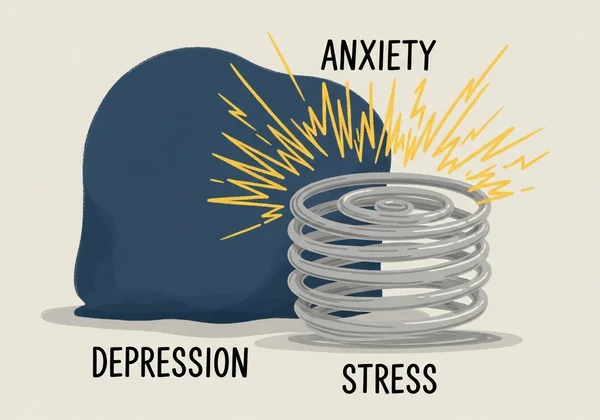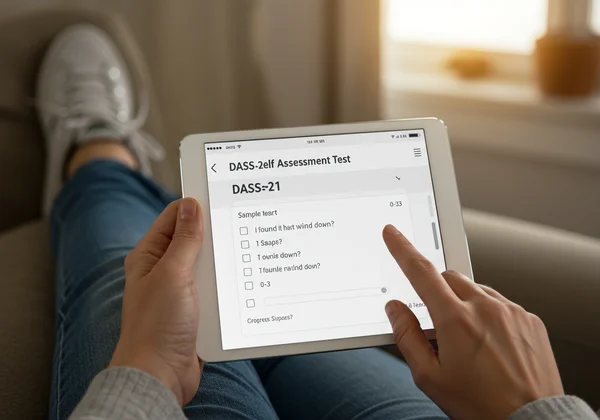Depression, Anxiety & Stress: A Guide to Symptoms & The DASS-21 Test
Feeling overwhelmed, perpetually worried, or persistently sad is a common part of the human experience. But how do you know if it's just a bad week or a sign of a more significant mental health concern? Understanding the differences between depression, anxiety, and stress is the crucial first step toward managing your emotional well-being.
This guide provides a clear, empathetic look at the symptoms, causes, and nature of each condition. We'll also explore the Depression, Anxiety, and Stress Scale (DASS-21), a valuable self-assessment tool designed to help you measure your emotional state. By the end, you'll have a clearer understanding of what you might be feeling and know what steps you can take next.

Understanding Depression: More Than Just Sadness
Depression is a complex mood disorder that causes a persistent feeling of sadness and a loss of interest in life. It significantly impacts how you feel, think, and behave, and can lead to a variety of emotional and physical problems. It is a medical condition, not a sign of weakness, and it isn't something you can simply "snap out of."
Common Emotional and Physical Symptoms of Depression
The experience of depression is multifaceted, manifesting in both our minds and bodies. While it varies from person to person, common signs include:
- Emotional Symptoms: A persistent sad or empty mood, feelings of hopelessness or pessimism, irritability, and a significant loss of interest or pleasure in most activities (anhedonia).
- Physical Symptoms: Noticeable changes in appetite or weight, sleep disturbances like insomnia or oversleeping, chronic fatigue or loss of energy, and unexplained aches, pains, or digestive problems.
- Cognitive Symptoms: Difficulty concentrating, remembering details, or making decisions, alongside pervasive feelings of worthlessness or excessive guilt.
How Depression Differs from Grief or Sadness
While sadness is a core component of depression, the two are not the same. Grief and sadness are normal reactions to a specific loss or difficult event. They often come in waves and may be interspersed with positive memories. Depression, in contrast, is a more pervasive and persistent state of low mood and disinterest that isn't always linked to a specific trigger. It colors your entire outlook on life, making it difficult to feel any sense of hope or joy.
What Causes Depression? Key Risk Factors
There is no single cause of depression; it typically results from a combination of factors. These can include:
- Genetics: A family history of depression can increase your risk.
- Brain Chemistry: Imbalances in neurotransmitters, the chemicals that regulate mood, play a significant role.
- Life Events: Trauma, chronic illness, difficult relationships, or prolonged stress can act as powerful triggers.
- Hormonal Changes: Fluctuations in hormones can contribute to the onset of depression.
Understanding Anxiety: Symptoms and Triggers
Anxiety is your body's natural response to stress—a feeling of fear or apprehension about what’s to come. While everyone feels anxious from time to time, for some, the worry can become excessive, persistent, and all-consuming, interfering with daily life.
What Does Anxiety Feel Like Physically?
Anxiety isn't just in your head; it triggers the body’s "fight or flight" response. This rush of adrenaline can cause a wide range of intense physical sensations, including:
- A racing heart or heart palpitations
- Sweating, trembling, or shaking
- Shortness of breath or a feeling of choking
- Chest tightness or pain
- Nausea or stomach discomfort
- Dizziness, lightheadedness, or feeling faint
- Hot or cold flashes
These physical feelings can be frightening and are sometimes mistaken for a heart attack, which can reinforce the cycle of fear and panic.

Differentiating Between Everyday Worry and an Anxiety Disorder
What separates normal worry from a potential anxiety disorder? The key differences lie in intensity, duration, and impact. Everyday worry is usually temporary and related to a specific, realistic problem. An anxiety disorder involves worry that is persistent, overwhelming, and often disproportionate to the actual situation. It disrupts your work, relationships, and ability to function day-to-day.
Common Triggers for Anxious Thoughts and Feelings
Anxious responses can be set off by various internal or external cues. Common triggers include high-pressure situations at work or school, financial strain, and social gatherings. Health concerns, conflict in relationships, major life changes, and even stimulants like caffeine can provoke anxiety. Identifying your personal triggers is an empowering step toward managing your response.
Managing Stress: When Does It Become a Problem?
Stress is the feeling of emotional or physical tension that arises from any event or thought that makes you feel frustrated, angry, or nervous. In short bursts, stress can be positive, helping you meet a deadline or avoid danger. But when it becomes chronic, it can seriously harm your health.
Eustress vs. Distress: Not All Stress Is Bad
It's important to recognize that not all stress is created equal. Psychologists differentiate between two types:
- Eustress: This is the beneficial kind of stress that motivates you, enhances focus, and feels exciting—like the jitters before a big presentation or a first date.
- Distress: This is the negative type of stress that causes anxiety, feels unpleasant, and can lead to a decline in physical and mental health. The goal isn't to eliminate all stress, but to manage distress effectively.
The Long-Term Effects of Chronic Stress
When your body is in a constant state of "fight or flight," the long-term overexposure to cortisol and other stress hormones can disrupt almost all your body's processes. This increases your risk for many health problems, including:
- Weakened immune system
- High blood pressure, heart attack, and stroke
- Mental health problems, such as depression and anxiety disorders
- Sleep problems and chronic fatigue
- Digestive issues
- Burnout and memory impairment
Signs That Your Stress Levels Are Too High
Recognizing the warning signs of chronic stress is key to taking action. Look out for cognitive symptoms like constant worrying and difficulty concentrating, emotional symptoms like irritability and feeling overwhelmed, and physical symptoms like headaches, muscle tension, and frequent colds.
The DASS-21 Test: A Tool for Self-Assessment
If you're trying to make sense of your feelings, a self-assessment can be an excellent starting point. The DASS-21 is a well-established tool for measuring emotional distress.
What Is the DASS-21 Scale?
The Depression, Anxiety, and Stress Scale - 21 Questions (DASS-21) is a questionnaire designed to measure the severity of a range of symptoms common to depression, anxiety, and stress. By answering 21 questions about your experiences over the past week, you receive three separate scores, one for each emotional state.

How to Interpret Your DASS-21 Scores
The test provides scores that are categorized from "Normal" to "Extremely Severe." These scores help you quantify what you've been feeling and can highlight which emotional state—depression, anxiety, or stress—is most prominent for you. It provides a clear, objective snapshot of your current emotional health.
Why a Self-Assessment Is a Good First Step
Taking a confidential self-assessment can validate your feelings and provide the clarity needed to seek help. It's a private, low-pressure way to check in with yourself. While it is not a diagnostic tool, its results can be a valuable resource to share with a doctor or mental health professional to start a conversation about your well-being. Take the free DASS-21 test here.
Pathways to Support: How to Manage Symptoms
Understanding your symptoms is the first step; taking action is the next. A combination of professional guidance, lifestyle changes, and personal support can make a significant difference.

Professional Help: Therapy and Counseling
Talking to a mental health professional is one of the most effective ways to manage depression, anxiety, and stress. Therapists can provide you with coping strategies, help you identify underlying causes, and offer evidence-based treatments like Cognitive Behavioral Therapy (CBT).
Lifestyle Adjustments for Mental Well-being
Small, consistent changes to your daily routine can have a powerful impact:
- Regular Exercise: Physical activity is a proven mood booster.
- Balanced Diet: What you eat can affect your mood and energy levels.
- Sufficient Sleep: Aim for 7-9 hours of quality sleep per night.
- Mindfulness and Relaxation: Practices like meditation, deep breathing, and yoga can help calm your nervous system.
Building a Strong Support System
Connecting with trusted friends, family, or support groups can combat feelings of isolation. Sharing your experiences with people who care can provide comfort, perspective, and encouragement.
Your First Step Towards Better Mental Health
Navigating the complexities of depression, anxiety, and stress can feel daunting, but you don't have to do it alone. Recognizing the symptoms is a sign of strength, not weakness. By understanding what you're feeling and using tools like the DASS-21, you can take an informed and empowered first step. Remember, seeking support is a proactive move towards reclaiming your well-being.
Frequently Asked Questions
1. Can you have depression, anxiety, and stress at the same time?
Yes, it's very common for these conditions to co-occur. Chronic stress can lead to anxiety and depression, and the symptoms often overlap. The DASS-21 is helpful because it measures each state separately, giving you a clearer picture of what you are experiencing.
2. How do I know if I need professional help?
If your symptoms are persistent, distressing, and interfere with your daily life—including your work, school, or relationships—it's a good idea to seek professional help. A screening tool can help you assess your symptom severity, but a consultation with a healthcare provider is the best way to get a formal diagnosis and treatment plan.
3. Is the DASS-21 test a diagnosis?
No, the DASS-21 is a screening tool, not a diagnostic tool. It can indicate the presence and severity of symptoms, but it cannot replace a comprehensive evaluation by a qualified mental health professional or doctor. It is best used as a starting point for a conversation about your mental health. For more information on diagnoses, you can consult authoritative sources like the National Institute of Mental Health (NIMH).